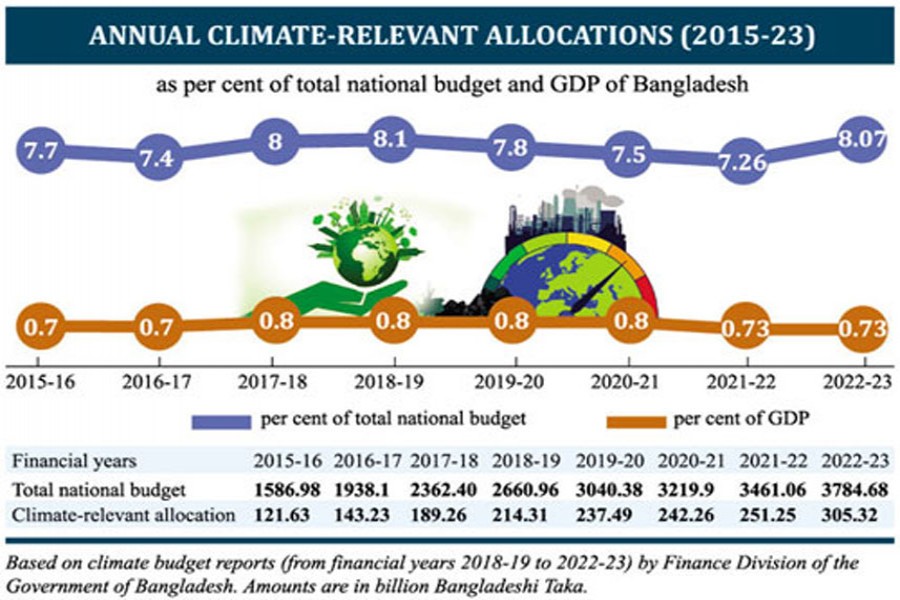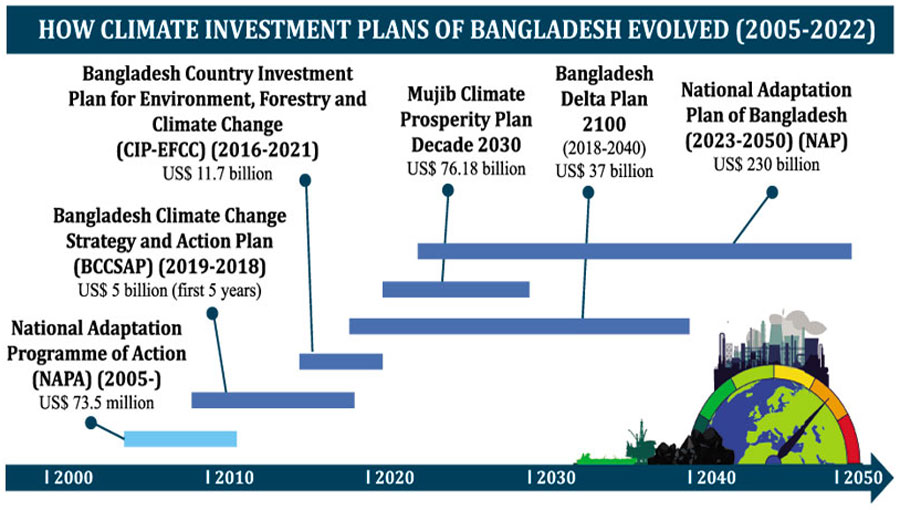
 For developing nations, the COP27 climate conference held in this November at Sharm El-Sheikh, Egypt has become a landmark event. The 'Sharm El-Sheikh Implementation Plan' agreed by the nations captures the steps towards establishing a new funding mechanism which will, hopefully, make additional funds available to address climate-induced losses and damages which is rapidly aggravating all over the world. Despite cynicism from some quarters, this recent-most development marks the end of a long-running fight between the less-developed climate-vulnerable countries and the developed ones to recognise the real costs of human-induced climate change. At the same time, it marks the start of a new era of climate finance.
For developing nations, the COP27 climate conference held in this November at Sharm El-Sheikh, Egypt has become a landmark event. The 'Sharm El-Sheikh Implementation Plan' agreed by the nations captures the steps towards establishing a new funding mechanism which will, hopefully, make additional funds available to address climate-induced losses and damages which is rapidly aggravating all over the world. Despite cynicism from some quarters, this recent-most development marks the end of a long-running fight between the less-developed climate-vulnerable countries and the developed ones to recognise the real costs of human-induced climate change. At the same time, it marks the start of a new era of climate finance.
Speaking of ensuring sufficient funds for climate action, the path has never been smooth. The developed countries were harshly criticised in the COP26 (2021) in Glasgow, UK for failing to channel US$ 100 billion a year since 2020. Besides bilateral channels, least-developed and developing nations can receive money from a number of climate pots, such as, Global  Environment Facility (GEF), which also manages the Least Developed Countries Fund (LDCF), Climate Investment Funds (CIF), Adaptation Fund (AF), and Green Climate Fund (GCF). Although these are governed by well-chalked-out rules and regulations, given their strict compliances and standards, it often seems quite challenging for developing nations or accredited agencies to win these competitive funds.
Environment Facility (GEF), which also manages the Least Developed Countries Fund (LDCF), Climate Investment Funds (CIF), Adaptation Fund (AF), and Green Climate Fund (GCF). Although these are governed by well-chalked-out rules and regulations, given their strict compliances and standards, it often seems quite challenging for developing nations or accredited agencies to win these competitive funds.
If we look into the GCF, since 2015, it has approved 209 projects worth US$ 11.4 billion. Bangladesh-a country which has hardly left the top 10 list of climate-vulnerable countries over the last 15 years-has so far received GCF's approval of seven projects. Five of these projects are exclusively for Bangladesh and two are part of large global projects. The total value of Bangladesh-only projects is US$ 607.8 million, to which GCF's contribution is US$ 374 million. Co-financing is a key part of GCF mechanism. The five projects, being implemented by international (KfW, UNDP, and World Bank) and national (PKSF and IDCOL) accredited entities, have ensured substantial co-financing ranging from 24 per cent to 51 per cent of the total project value.
Overall progress of Bangladesh-only projects is quite promising. For example, three projects which started in or before 2019 have already received 50 per cent to 80 per cent of GCF allocations. Nevertheless, the first GCF project (Climate Resilient Infrastructure Mainstreaming, CRIM) approved seven years back in November 2015 has so far received 12 per cent of GCF grants (US$40 million). While the latest annual performance report of this project published in 2021 blames the COVID-19 pandemic for the delay in project implementation, slow tendering process reportedly slowed down this infrastructure project well before the coronavirus dominated the world.
According to Finance Division's Climate Budget Report (2021-22), the government identified 48 potential climate projects worth US$ 3.17 billion hoping that 72 per cent of this amount would be coming from the GCF. Almost all of these projects are very much in line with the climate investment plans Bangladesh has recently prepared, as discussed below.
Among other large climate funds, Bangladesh has so far received US$ 193.82 million to implement 12 CIF-approved projects with US$1.85 billion as matching fund. Around 62 per cent of this co-financing came from multilateral development banks. In June 2021, Bangladesh started a 5-year-long Adaptation Fund project where diverse soft and hard adaptative measures will be implemented on coastal and riverine Islands. UNDP is implementing this US$ 10-million initiative on behalf of Department of Environment where Adaptation Fund has already disbursed 26 per cent of the total fund.
The history of Bangladesh's climate finance, however, goes way beyond the above global funding sources. Being a disaster-prone country, Bangladesh always had to arrange money for disaster preparedness be it establishing and maintaining Cyclone Preparedness Programme (CPP) or building cyclone and flood shelters throughout the country or maintaining coastal polders and riverine embankments, along with, allocating resources for disaster response and rehabilitation.
Around 20 years back, responding to climate change through exclusive planning and funding arrangements got prominence. Since 2005, Bangladesh has from time to time, prepared investment plans to address impacts of climate change. The accompanied diagram shows how these plans evolved in terms of their scopes, time span, and volume of the envisaged investments.
Many of the 15 project ideas outlined in the National Adaptation Programme of Action (NAPA, 2005) remained unimplemented in the following years. Things changed with the Bangladesh Climate Change Strategy and Action Plan (BCCSAP)?a milestone planning instrument of the country to address climate change. After its formulation in 2008 and revision in 2009, the government established the Bangladesh Climate Change Trust Fund (BCCTF) in 2010 to implement this plan. As of May 2021, about 800 projects were implemented by spending US$450 million from this fund. A multi-donor fund, the Bangladesh Climate Change Resilience Fund (BCCRF), was also established in 2010 to support BCCSAP's implementation. The BCCRF disbursed US$71.13 million by December 2016 then discontinued before exhausting its total deposit (US$ 130.28 million). Being a 10-year-long plan, the BCCSAP (2009)'s revision started in 2018. Although the BCCTF funded hundreds of projects, including the formulation of Bangladesh National Conservation Strategy (NCS), it was GIZ (a German development partner) who financed the BCCSAP's revision. Moreover, more than four years have passed, but the revised BCCSAP is yet to be made public. Such instances sometimes prompt us to ask how motivated our government is to plan climate action.
The formulation process of Bangladesh Country Investment Plan for Environment, Forestry and Climate Change (CIP-EFCC, 2016) was quite promising, which was accompanied by a monitoring mechanism. That momentum wasn't seen in the following years, as agencies involved discontinued supporting the process, while the government missed the opportunity to embrace this CIP as a useful tool. Prepared in 2018, Bangladesh Delta Plan 2100 (BDP2100), on the other hand, has been mainstreamed in the subsequent development plans of Bangladesh, such as Eighth Five-Year Plan (2020-2025), draft Mujib Climate Prosperity Plan Decade 2030 (MCPP), and National Adaptation Plan of Bangladesh (2023-2050) (NAP). The BDP2100, however, envisages US$2 billion per year from the GCF, to implement its 52 adaptation projects worth US$23.23 billion. Four years on, the reality is far from this expectation.
The draft Mujib Climate Prosperity Plan (MCPP, 2021) is innovative for several reasons. First, it shifts our development philosophy from "vulnerability to resilience" to "resilience to prosperity". It has also prompted Ghana, the Maldives, and Sri Lanka to prepare their own Climate Prosperity Plans. Second, the MCPP embraces three widely discussed climate change approaches: i) Locally-led Adaptation (LLA) for effectively integrating local actors in climate action, ii) Nature-based Solutions (NbS) to capitalise on ecosystems' potentials to address climate change impacts, and iii) Just Transition (JT) to ensure equitable transformation in our labour market as we rapidly shift towards a low-carbon economy.
Third, the MCPP proposes many mechanisms to finance its US$76.18 billion worth of activities by 2030.Examples include, i) blending public and private investments; ii) introducing different bonds, such as resilience bonds (for combining social and sustainability outcomes), green bonds (for positive environmental impact), and blue bonds (for marine conservation); iii) exploring GCF's Private Sector Facility (PSF), CIF, GEF, voluntary carbon market (VCM), and joint carbon fund under V20 (the Vulnerable Twenty Group consisting of climate-vulnerable countries); iv) expanding the coverage of the BCCTF, National Human Resource Development Fund, and Bangladesh Bank's Green Transformation Fund; v) establishing National Carbon Finance Coordination Hub; and vi) preparing Mujib Comprehensive Climate and Disaster Risk Management and Financing Strategy.
The National Adaptation Plan (NAP, 2022), approved by the government just a few days before the COP27, also proposes many funding mechanisms. The NAP implementation is expected to strengthen climate-inclusive public financial management system by updating the current climate fiscal framework for transparent and effective generation and utilisation of climate finance from all possible sources. Like the MCPP, the NAP also envisages harnessing the potentials of global climate funds, and domestic sources such as blended finance, introducing green/climate bonds, and insurance. Other options included in the NAP are introducing low interest loan for adaptation and payment for ecosystem services instruments, establishing local government fund for climate risk management, updating corporate social responsibility (CSR) policies of Bangladesh Bank and private banks, and exploring other biodiversity and environmental funds (e.g., Nature+Accelerator Fund and CCAFS-CGIAR Fund). The NAP also envisages updating the Bangladesh Climate Change Trust Act, 2010 to establish an exclusive unit under the Ministry of Environment, Forest, and Climate Change (MoEFCC) to coordinate and mobilise funds from a wide range of domestic and international sources for the BCCTF.
Bangladesh first prepared its Climate Fiscal Framework in 2014, which was updated in 2020. Over the last few years, the Government of Bangladesh has been estimating the climate-relevant allocations within its national budget. The accompanied figure and table show the total annual national budgets, respective climate-relevant allocations, both in absolute numbers and as percentages of the national budgets and as percentages of Bangladesh's GDP, since 2015-2016 financial years. Despite 2.4 times increase of Bangladesh's total budget over the last seven years and the devastating effects of the COVID-19 pandemic, Bangladesh has managed to maintain its climate budget allocations till now.
Keeping in mind Bangladesh's climate financing experience over the last 17 years, we can actively focus on three pertinent areas.
First, both the MCPP (2021) and the NAP (2022) strongly embrace NbS. This shows the importance of nature in addressing adverse impacts of climate change. The Article 36 of Bangladesh Biodiversity Act, 2017 has the provision for establishing a Biodiversity Conservation Fund. Five years on, no step has been taken to establish this fund. By financing NbS, the Biodiversity Conservation Fund can help us to address two crises at the same time: climate crisis and ecological crisis. The Bangladesh Parliament also acknowledged this fact by unanimously adopting a motion on 'planetary emergency' in November 2019, just before the coronavirus shook the world. The MoEFCC should take necessary actions to establish the Biodiversity Conservation Fund to diversify and maximise the use of our biodiversity and climate funds. The MCPP and the NAP also underscore this intention.
Second, climate change exacerbates social inequity. Climate finance should be distributed in an equitable manner-geographically and across the sections of a society based on observed and predicted climate change impacts. We need to follow eight Locally-led Adaptation (LLA) principles which have already been endorsed by about 100 entities around the world. The LLA principles which are related to finance promote predictable and easily accessible funding for the local stakeholders (Principle 3), investing in local actors and institutions so that they don't rely only on project funding (Principle 4), tackling uncertainties of adaptation by flexible funding (Principle 6), transparency and accountability in financing (Principle 7), and collaboration among humanitarian, development, disaster risk reduction, and green recovery-related funding sources to enhance efficiency (Principle 8). As government and private agencies implement climate action plans, they should follow to the LLA principles to promote social equity on the ground while channelling climate funds.
Finally, Bangladesh's climate finance essentially focuses on adaptation. The country through its latest Nationally Determined Contributions (NDC, 2021) is, however, committed to reduce its greenhouse gas emissions by 6.73 per cent on its own and an additional 15.12 per cent with international assistance, by 2030. In the wake of intense and frequent natural calamities, we have apparently left the 'age of adaptation' and have entered the 'age of loss and damage'. But, we cannot wait for loss and damage funding arrangement to be established; we didn't do so when the world was lagging behind providing adaptation funds. We need to expedite the implementation of Bangladesh Climate Fiscal Framework (2020) supported by increased climate budget allocations, robust institutional coordination, stronger skills development, and faster policy reform. This should balance our climate financing for mitigation, adaptation, and loss and damage, and create synergy among our climate action plans.
Dr. Haseeb Md. Irfanullah is an independent consultant working on environment, climate change, and research systems.
His Twitter handle is @hmirfanullah
© 2025 - All Rights with The Financial Express
